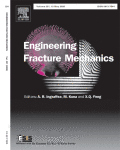|
Autores/as
Bahmari, Bahador; Ayatollahi, Majid R.; Sedighi, Iman; Pérez, Marco A. ; Garcia-Granada, Andrés A. ; Garcia-Granada, Andrés A.
|
Abstract
Mechanical components produced by the 3D-printing technique contain small voids by nature, which make them susceptible to fracture. Therefore, understanding the fracture behavior of these components improves the applicability of this manufacturing method. In this study, the effect of layer orientation is investigated on the mixed-mode I/II fracture behavior of additively manufactured poly-carbonate produced using a fused deposition modelling (FDM) printer. A total of 48 semi-circular bend (SCB) specimens with different mode mixities and printing orientations are tested. The curves for the maximum tangential stress (MTS) and the generalized MTS (GMTS) criteria are then produced using the mode I fracture properties for the weakest and the strongest direction of the printed material. This results in two failure curves for each of the criteria. Comparing the mixed-mode fracture toughness data with these curves, it is observed that all the data are placed between the two GMTS curves (regarding error bands). As an engineering approach, the band created by the GMTS curves, called the GMTS range, is suggested as an acceptable band for use in engineering designs. Furthermore, in a more detailed analysis, the fracture paths of the specimens are correlated with the position of the experimental data in the GMTS range. Three different fracture modes occur during the tests depending on the layer orientation and mode mixity of the sample. The inter-layer and the cross-layer modes correspond to the data points on the lower and upper fracture curves, while the data points in the middle represent the samples undergoing the crack multi-kinking mode.
|

WoS
Scopus
Altmetrics
 
|
